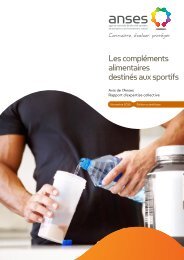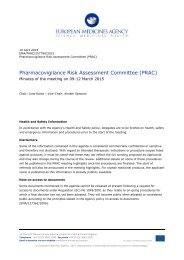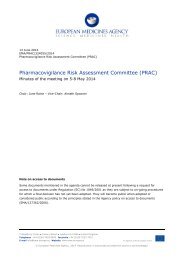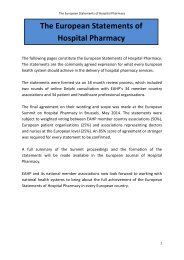WC500165698
WC500165698
WC500165698
Create successful ePaper yourself
Turn your PDF publications into a flip-book with our unique Google optimized e-Paper software.
Explanatory notes<br />
The notes give a brief explanation of relevant minutes items and should be read in conjunction with the minutes.<br />
EU Referral procedures for safety reasons: Urgent EU procedures and Other EU referral procedures<br />
(Items 2 and 3 of the PRAC agenda)<br />
A referral is a procedure used to resolve issues such as concerns over the safety or benefit-risk balance of a medicine or a class of<br />
medicines. In a referral, the EMA is requested to conduct a scientific assessment of a particular medicine or class of medicines on<br />
behalf of the European Union (EU). For further detailed information on safety-related referrals please see:<br />
http://www.ema.europa.eu/ema/index.jsp?curl=pages/regulation/general/general_content_000150.jsp&mid=WC0b01ac05800240d<br />
0<br />
Signals assessment and prioritisation<br />
(Item 4 of the PRAC Minutes)<br />
A safety signal is information on a new or incompletely documented adverse event that is potentially caused by a medicine and that<br />
warrants further investigation. Signals are generated from several sources such as reports of adverse events from healthcare<br />
professionals or patients (so called spontaneous reports), clinical studies and the scientific literature. The evaluation of safety signals<br />
is a routine part of pharmacovigilance and is essential to ensuring that regulatory authorities have a comprehensive knowledge of a<br />
medicine’s benefits and risks.<br />
The presence of a safety signal does not mean that a medicine has caused the reported adverse event. The adverse event could be<br />
a symptom of another illness or caused by another medicine taken by the patient. The evaluation of safety signals is required to<br />
establish whether or not there is a causal relationship between the medicine and the reported adverse event.<br />
After evaluation of a safety signal the conclusion could be that the medicine caused the adverse reaction, that a causal relationship<br />
with the adverse event was considered unlikely, or that no clear answer could be given and the signal therefore is to be further<br />
investigated. In cases where a causal relationship is confirmed or considered likely, regulatory action may be necessary and this<br />
usually takes the form of an update of the product information (the summary of product characteristics and the package leaflet).<br />
For completeness the information on signals is complemented, when available, by information on worldwide population exposure.<br />
Risk Management Plans (RMPs)<br />
(Item 5 of the PRAC Minutes)<br />
The RMP describes what is known and not known about the safety of a medicine and states how the side effects will be prevented or<br />
minimised in patients. It also includes plans for studies and other activities to gain more knowledge about the safety of the medicine<br />
and risk factors for developing side effects.<br />
RMPs are continually modified and updated throughout the lifetime of the medicine as new information becomes available.<br />
Assessment of Periodic Safety Update Reports (PSURs)<br />
(Item 6 of the PRAC Minutes)<br />
A PSUR is a report providing an evaluation of the benefit-risk balance of a medicine, which is submitted by marketing authorisation<br />
holders at defined time points following a medicine’s authorisation.<br />
PSURs summarise data on the benefits and risks of a medicine and include the results of all studies carried out with this medicine (in<br />
the authorised and unauthorised indications).<br />
Post-authorisation Safety Studies (PASS)<br />
(Item 7 of the PRAC Minutes)<br />
A PASS is a study of an authorised medicinal product carried out to obtain further information on its safety, or to measure the<br />
effectiveness of risk minimisation activities that have been introduced. The results of a PASS help regulatory agencies to further<br />
evaluate the safety and benefit-risk profile of a medicine already in use.<br />
Product-related pharmacovigilance inspections<br />
(Item 9 of the PRAC Minutes)<br />
These are inspections carried out by regulatory agencies to ensure that marketing authorisation holders have systems in place that<br />
enable them to comply with their obligations to closely follow the safety of a medicine after authorisation.<br />
More detailed information on the above terms can be found on the EMA website: www.ema.europa.eu/<br />
The use and indications of some of the medicines mentioned as background information in the minutes is described in abbreviated<br />
form. We recommend the readers to refer to the EMA website: ‘Search for medicines’ to find the full product information (Summary<br />
of the Product Characteristics and Package Leaflet) of all centrally authorised medicines included.<br />
Pharmacovigilance Risk Assessment Committee (PRAC)<br />
EMA/PRAC/253432/2014 Page 2/64








